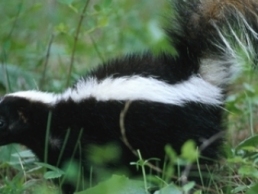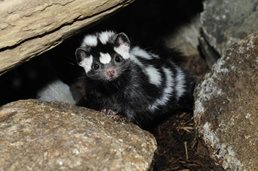How to Identify a Skunk Living on Your Property
There are several ways to identify the presence of a skunk on your property. The most obvious way to identify a skunk is seeing it. Skunks are generally 20-32 inches long with short legs and an unusual gait. They are known for their bushy tails and black and white stripes although species differ in their markings. Here are a few other ways skunks make their presence known.
Skunk Tracks

Skunks leave distinct tracks in dirt, mud, and snow. Skunks have five toes on each foot and claws that extend from each toe. The claws make deep tracks on the fore feet and differentiate skunk tracks from that of the common house cat, which can retract their claws. The hind foot leaves the mark of a heel pad that is usually between two and two-and-a-half inches.
Skunk Scat
Skunk feces typically measures around half an inch in diameter and between one and two inches in length. Often compared to cat feces, skunk droppings can take on slightly different colors and shapes depending on the weather, the contents of their meals, and the length of time from the initial deposit. Skunk feces generally contains bits of undigested insects, berry seeds, fur, or feathers. Skunk feces can appear similar to raccoon feces but is typically smaller.
Skunk Burrows
Skunks use their digging ability to build tunnels, dens, and forage for food on residential and commercial property. Their burrows are often found under buildings, sheds, decks, and even concrete foundations. Dens and tunnels built by skunks are marked by freshly excavated dirt and a strong odor. Holes dug by skunks for food are shallower and just a couple of inches in diameter.

Skunk Smell
Skunks are infamous for their pungent spray — an oil stored in their anal glands that can be sprayed up to 12 feet. Skunk spray includes chemicals known as thiols, which are compounds that contain sulfur. These chemical compounds give the liquid its musky stench, which can be smelled up to a mile away in certain conditions. Skunks typically use their spray as a last defense against predators. While the spray is rarely permanently harmful, it is extremely difficult to remove and can cause irritation to the skin and olfactory senses. Skunk spray can even cause temporary vision loss.
Skunk Sounds
Skunks are generally quiet, but they do growl, squeal, hiss, and stomp. Skunks typically use these sounds to signal distress. A pregnant skunk will use these sounds to warn approaching males. Homeowners might hear the tapping or scratching of skunk claws at night because the animals are nocturnal.
Types of Skunks
Five species of skunks live in the United States – striped skunk, spotted skunk, hooded skunk, American hog nosed skunk. Skunks are commonly found in wooded areas, open fields, pastures, and open lands bordering forested regions.
Striped Skunk

Striped skunks are found throughout the United States with an exception of a few areas in Utah and Nevada.
They typically grow 32 inches in length and weigh approximately 14 pounds, similar in size to a typical house cat. The striped skunk is easily recognized due to its black fur and prominent white markings. The average adult skunk has one stripe running from the tip of their snout to the crest of their forehead, as well as a stripe that runs down the length of their back. Other prominent features include bushy tails, triangle-shaped heads, small ears, and black eyes.
Spotted Skunk

Spotted skunks are smaller and more agile than striped skunks. They grow between one and two feet in length and weigh around one-and-a-half pounds. Spotted skunks have black fur with erratic white striping and feature a white spot on their forehead. These skunks are commonly found near forests, where they make use of their squirrel-like climbing ability.
s
The eastern spotted skunk ranges across the Great Plains to Texas and Florida then up the Appalachians. The western spotted skunk is in west Texas, Arizona, New Mexico, Colorado, Utah, Nevada, California, Oregon, eastern Washington, most of Idaho, western Wyoming, and southeast Montana.
Hog-nosed Skunk
Hog-nosed skunks are larger than other North American skunk species, growing to about three feet in length. They also feature short, white tails, a single white stripe on their backs, and a wide nose absent of fur. Hog-nosed skunks live in the Southwest including southern Colorado, New Mexico, Arizona, and southeastern Texas.
Hooded Skunk
The hooded skunk range includes southeastern Arizona, southwestern New Mexico, and southwestern Texas.Hooded skunks are smaller and leaner than other skunk species and typically only weigh five pounds. They have triangularly shaped heads, sharp teeth, small ears, and their tails are longer than their bodies. Hooded skunks tend to bear one of three distinct colorations: white-backed, black-backed, or all black.
Skunks have adapted to rural and suburban areas, including farmlands and suburban neighborhoods. The readily available food sources like garbage, grubs and larvae in yards, or pet food attract skunks.
Skunk Den
Mostly active at night, skunks typically use burrows abandoned by other animals to build dens but will also use hollow logs, brush or rock piles, rock crevices, woodpiles and culverts to avoid detection.
Skunks are burrowing animals that, despite being timid, adapt surprisingly well to living among humans in urban areas. Den sites in residential areas usually are under decks, porches, and sheds. Burrows can be as deep as a foot down. We have found skunks living in crawl spaces too.
Can Skunks Climb?
They are not skilled climbers, so homeowners don’t need to fear them getting into attics and chimneys. Occasionally, homeowners will find skunks stuck in basement window wells because they cannot climb out.
Why is a Skunk Living in my Yard?
Readily available food, water and shelter will attract skunks to an area. There are certain times of year that skunks are more active usually during mating season, birthing season, or during pre-hibernation.
Skunk mating season starts around Valentine’s Day, and you will smell a skunk in your yard.
Female skunks select den sites that are quiet and dark for the sense of security these sites afford their young. Skunks that live in residential areas are known to find comfort underneath porches and decks.
Skunk Control
If you believe a skunk is living in or around your house, the worst course of action would be to try to catch it yourself, unless getting sprayed by a skunk is terrible. Skunk spray is a defensive mechanism. Before they spray, they stamp their front feet as a warning. If you hear that, turn around.
When dealing with skunks, noise and light are very effective deterrent measures. Try placing a battery-powered radio tuned to an all-talk station outside of the den. You can also try consistently shining a light directly toward the den. These methods, especially if used in conjunction, will hopefully disturb the skunk enough to where it’ll start packing its bags.